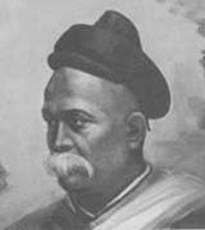Puneri Pagadi
Puneri Pagadi is a traditional Indian turban that originates from Pune, a city in the state of Maharashtra, India. This headgear has been a symbol of pride and honor for the people of Pune and the Marathi culture for centuries. The Puneri Pagadi is not just a piece of cloth but a cultural emblem that represents the ethos and heritage of the region.
History[edit | edit source]
The history of the Puneri Pagadi dates back to the era of the Maratha Empire, when it was worn by the Maratha warriors and nobles as a symbol of valor and prestige. Over time, it became an integral part of the traditional Maharashtrian attire, especially during formal occasions and festivals. The design and the way of wearing the pagadi have evolved, but its significance has remained unchanged.
Design and Varieties[edit | edit source]
The Puneri Pagadi is known for its distinctive shape and color. Traditionally, it is made of a single piece of cloth, usually cotton or silk, and is available in various colors, although saffron is the most popular and culturally significant. The pagadi is intricately tied and has a stiff base to maintain its shape. There are different styles of tying the Puneri Pagadi, each representing a different status or profession in society.
Cultural Significance[edit | edit source]
The Puneri Pagadi is more than just a piece of clothing; it is a symbol of respect, pride, and the rich cultural heritage of Maharashtra. It is often worn during traditional ceremonies, weddings, and festivals such as Gudi Padwa (Marathi New Year) and Dussehra. The pagadi is also a symbol of honor; it is presented to individuals as a mark of respect and recognition for their achievements or contributions to society.
Modern Day Relevance[edit | edit source]
In contemporary times, the Puneri Pagadi has seen a resurgence in popularity, with people embracing it as a fashion statement and a way to connect with their cultural roots. It is also promoted by cultural organizations and at heritage events to keep the tradition alive among the younger generations.
Preservation Efforts[edit | edit source]
Efforts are being made to preserve the art of making and tying the Puneri Pagadi. Artisans who specialize in crafting these turbans are being supported by various cultural organizations to ensure that this traditional skill is not lost. Workshops and demonstrations are also organized to teach the younger generation about the significance and the correct way to wear the pagadi.
Conclusion[edit | edit source]
The Puneri Pagadi is an integral part of the cultural identity of Pune and Maharashtra. It stands as a testament to the region's history, traditions, and values. As a symbol of honor and pride, it continues to be cherished and respected by the people, ensuring its place in the cultural heritage of India.
Navigation: Wellness - Encyclopedia - Health topics - Disease Index - Drugs - World Directory - Gray's Anatomy - Keto diet - Recipes
Search WikiMD
Ad.Tired of being Overweight? Try W8MD's physician weight loss program.
Semaglutide (Ozempic / Wegovy and Tirzepatide (Mounjaro / Zepbound) available.
Advertise on WikiMD
WikiMD is not a substitute for professional medical advice. See full disclaimer.
Credits:Most images are courtesy of Wikimedia commons, and templates Wikipedia, licensed under CC BY SA or similar.Contributors: Prab R. Tumpati, MD

